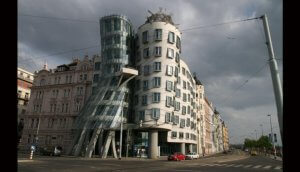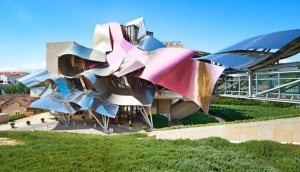The Architecture of Frank Gehry - A Modern Master

You’ve probably heard about some of the new artistic movements that people have been engaging in during recent decades. One example is the architecture of Frank Gehry. He’s an amazing creator who builds buildings with extremely unique designs.
Contemporary art still hasn’t reached its limits. There are no fixed rules for art in this day and age, and many pieces use abstraction as a tool. Artists don’t feel the pressure to use traditional shapes or patterns or to create new commonplace formats.
In the contemporary world, the artist is able to give their imagination free rein and find new ways to express themselves. In the case of architecture, that takes the form of innovative structures that look nothing like the work of other architects. Taking a look at some of the work of the 20th century makes that more than evident.
Who is Frank Gehry?

Born in Toronto, Canada in 1929, this architect is now considered one of the greatest of all time for his designs. He got his degree in architecture from the University of Southern California, though he also did some studying at Harvard and in Paris.
While he was in France he had a chance to see the work of Le Corbusier. This French architect was a major source of inspiration for Gehry. The French capital of Paris also stimulated him a great deal and gave him the opportunity to connect with lots of other artists in the mid 20th century.
The buildings he designed as an architect were a clear sign of what he had to offer to the art world. His work was completely innovative. Ultimately, it was New York where he worked on some of the most important designs of his career.
“Dull glass boxes are cold and not friendly to humanity and I am trying to change some of that.”
-Frank Gehry-
Fundamental characteristics of Frank Gehry’s architecture

Each of Frank Gehry’s buildings is different from the next. There’s no repeated formula in his work. At the same time, there is an essence to them that makes it clear they’re by him, and no one else. Here are some of the intrinsic characteristics in the majority of his designs that make them so unique.
- The first thing to understand here is how Frank Gehry conceived the buildings he was designing. He saw buildings as sculptures that could be molded. This is why you’ll so often see a sense of plasticity in his work.
- At no point does he lose sight of the functional aspects of a building. He’s always thinking about who he’s designing it for and what purpose it has in relation to us. In other words, he has continued with an idea that Le Corbusier had too, that there’s an important relationship between function and aesthetics.
- Playing around with volume, he uses the various structures to create distinctions between all the parts of the building. Each part has a completely avant-garde design. He also uses unusual shapes, and certainly not ones we’re used to seeing in buildings.
- It might not look like it, but Gehry always tries to use geometrical designs as foundations for the buildings. What he does is try to make it so that’s not obvious to us as we look at it. He changes the shapes a bit and gives them an aesthetic twist that’s like his personal signature.
Some similarities between his work

One interesting example of two buildings that have some similarities is in the Guggenheim Museum in Bilbao and the Hotel Marqués de Riscal in Elciego, Spain. Both buildings have a strong sense of Gehry’s personality and artistic touch.
The museum is more of an attempt to create a sense of openness by using its shapes to divide up the various parts of the building. There’s supposed to be a clearer sense of geometry. The hotel has more of a feeling of aesthetics in-motion. Plasticity plays a big role in this building.
You can’t forget that a dynamic feeling is key to the architecture of Frank Gehry. That’s definitely the case with both of these buildings, and it’s all a part of the way he uses shapes and layout to totally deconstruct the traditional systems of architecture.
Both buildings are perfect examples of innovation and the avant-garde.
The architecture of Frank Gehry and the playfulness of his designs

To put it simply, Frank Gehry’s designs are a total break from conservative ideas of architecture. He has always tried to create innovative structures that generate a feeling of movement and new directions in art. One good place to look for that is the Massachusetts Institute of Technology (MIT).
This is an architect who has always played around with shapes and tried to use architecture to express his full imagination and creativity. Two of our favorites are the Vitra Design Museum in Rhein, Germany and the Weisman Art Museum in Minneapolis, Minnesota. If you ever have a chance, go see his buildings in person! You won’t regret it.
You’ve probably heard about some of the new artistic movements that people have been engaging in during recent decades. One example is the architecture of Frank Gehry. He’s an amazing creator who builds buildings with extremely unique designs.
Contemporary art still hasn’t reached its limits. There are no fixed rules for art in this day and age, and many pieces use abstraction as a tool. Artists don’t feel the pressure to use traditional shapes or patterns or to create new commonplace formats.
In the contemporary world, the artist is able to give their imagination free rein and find new ways to express themselves. In the case of architecture, that takes the form of innovative structures that look nothing like the work of other architects. Taking a look at some of the work of the 20th century makes that more than evident.
Who is Frank Gehry?

Born in Toronto, Canada in 1929, this architect is now considered one of the greatest of all time for his designs. He got his degree in architecture from the University of Southern California, though he also did some studying at Harvard and in Paris.
While he was in France he had a chance to see the work of Le Corbusier. This French architect was a major source of inspiration for Gehry. The French capital of Paris also stimulated him a great deal and gave him the opportunity to connect with lots of other artists in the mid 20th century.
The buildings he designed as an architect were a clear sign of what he had to offer to the art world. His work was completely innovative. Ultimately, it was New York where he worked on some of the most important designs of his career.
“Dull glass boxes are cold and not friendly to humanity and I am trying to change some of that.”
-Frank Gehry-
Fundamental characteristics of Frank Gehry’s architecture

Each of Frank Gehry’s buildings is different from the next. There’s no repeated formula in his work. At the same time, there is an essence to them that makes it clear they’re by him, and no one else. Here are some of the intrinsic characteristics in the majority of his designs that make them so unique.
- The first thing to understand here is how Frank Gehry conceived the buildings he was designing. He saw buildings as sculptures that could be molded. This is why you’ll so often see a sense of plasticity in his work.
- At no point does he lose sight of the functional aspects of a building. He’s always thinking about who he’s designing it for and what purpose it has in relation to us. In other words, he has continued with an idea that Le Corbusier had too, that there’s an important relationship between function and aesthetics.
- Playing around with volume, he uses the various structures to create distinctions between all the parts of the building. Each part has a completely avant-garde design. He also uses unusual shapes, and certainly not ones we’re used to seeing in buildings.
- It might not look like it, but Gehry always tries to use geometrical designs as foundations for the buildings. What he does is try to make it so that’s not obvious to us as we look at it. He changes the shapes a bit and gives them an aesthetic twist that’s like his personal signature.
Some similarities between his work

One interesting example of two buildings that have some similarities is in the Guggenheim Museum in Bilbao and the Hotel Marqués de Riscal in Elciego, Spain. Both buildings have a strong sense of Gehry’s personality and artistic touch.
The museum is more of an attempt to create a sense of openness by using its shapes to divide up the various parts of the building. There’s supposed to be a clearer sense of geometry. The hotel has more of a feeling of aesthetics in-motion. Plasticity plays a big role in this building.
You can’t forget that a dynamic feeling is key to the architecture of Frank Gehry. That’s definitely the case with both of these buildings, and it’s all a part of the way he uses shapes and layout to totally deconstruct the traditional systems of architecture.
Both buildings are perfect examples of innovation and the avant-garde.
The architecture of Frank Gehry and the playfulness of his designs

To put it simply, Frank Gehry’s designs are a total break from conservative ideas of architecture. He has always tried to create innovative structures that generate a feeling of movement and new directions in art. One good place to look for that is the Massachusetts Institute of Technology (MIT).
This is an architect who has always played around with shapes and tried to use architecture to express his full imagination and creativity. Two of our favorites are the Vitra Design Museum in Rhein, Germany and the Weisman Art Museum in Minneapolis, Minnesota. If you ever have a chance, go see his buildings in person! You won’t regret it.
All cited sources were thoroughly reviewed by our team to ensure their quality, reliability, currency, and validity. The bibliography of this article was considered reliable and of academic or scientific accuracy.
- Haag Bletter, Rosemarie: La arquitectura de Frank Gehry, Gustavo Gili, 1988.







